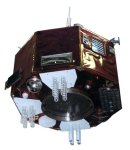TIMATION
Navigation Technology Satellite (NTS)
The Naval Research Laboratory's (NRL's) Naval Center for Space Technology (NCST) conceived the TIMATION (TIMe/navigATION) program in 1964 and launched the TIMATION I satellite in 1967 and the TIMATION II satellite in 1969. TIMATION proved that a system using a passive ranging technique, combined with highly accurate clocks, could provide the basis for a new and revolutionary navigation system with three-dimensional coverage (longitude, latitude, and altitude) throughout the world. NCST's TIMATION program paved the way for what eventually became the Global Positioning System (GPS).
In 1973, the TIMATION program was merged with the Air Force's 621B program, with the Air Force being named as the Executive Service, to form the NAVSTAR GPS program. NRL'S TIMATION III satellite was redesignated the Navigation Technology Satellite 1 (NTS-1) and was launched in the summer of 1974 in connection with the NAVSTAR effort. NTS-1 had two rubidium-vapor frequency standards (clocks), while the earlier TIMATION satellites had carried selected high-performance crystal oscillator clocks to test the NRL theory.
The successful launch of NTS-2 marked the beginning of a new era in navigation and timekeeping history. NTS-2 was launched on 23 June 1977 as the first NAVSTAR GPS Phase I satellite. NTS-2 technological features included cesium frequency standards, a nickel-hydrogen battery, three-axis gravity-gradient stabilization with momentum-wheel unloading, control of the spacecraft orbit, laser retroreflectors, solar-cell experiments, radiation dosimeters, and a worldwide network for data acquisition. The satellite experiment has verified Einstein's relativistic clock shift.
All of the NTS and TIMATION satellites were designed, built, and tested by the SED at NRL'S Payload Processing Facility in Washington, D.C.


|
NEWSLETTER
|
| Join the GlobalSecurity.org mailing list |
|
|
|

